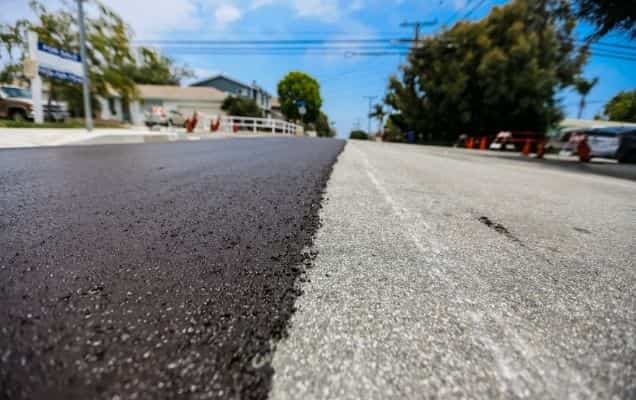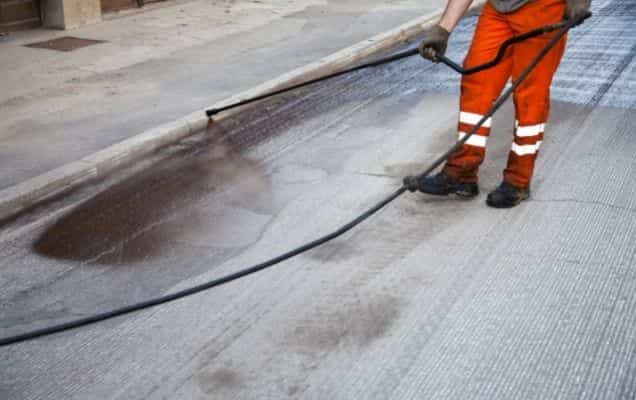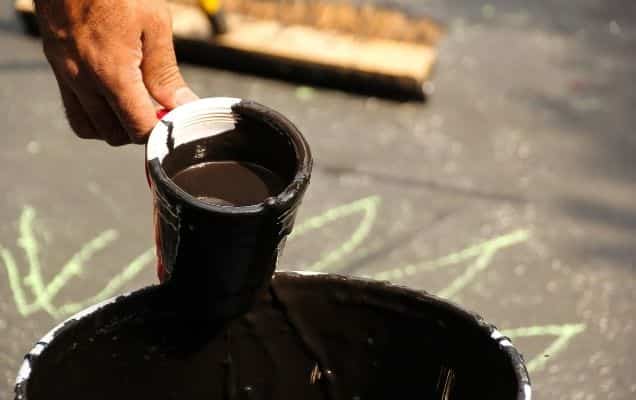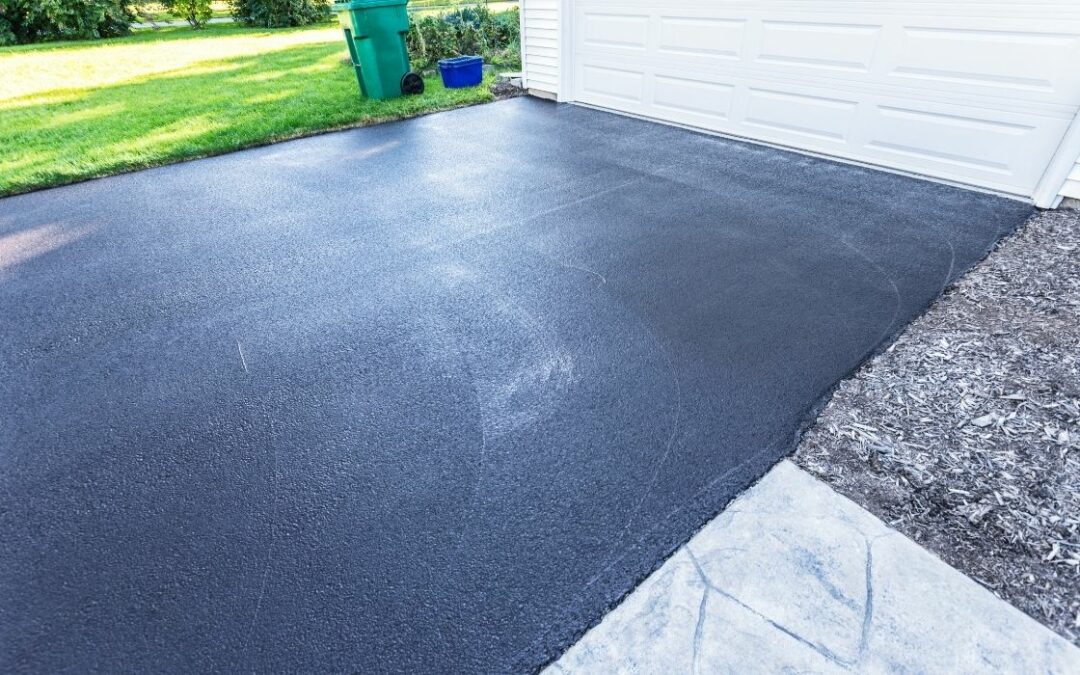I have had the opportunity to respond to many questions pertaining to sealcoating, based both on refined tar and asphalt, during my many years of lecturing and day to day service to our customers. The following is a condensed list of questions and my answers which are frequently asked.
Sealcoating

1. Why are two thin coats of a sealcoating is better than one thick coat?
Sealcoatings applied in two coats dries and cures much better than one thick coat application. Sealcoatings are commonly water-based coatings, which cure through the process of water release (evaporation). Also, sealcoating film dries from top to bottom, meaning top layers dry faster then from the bottom layers. A thin coat will release water much faster than a thick coat.
If the sealcoating is applied in one thick coat instead of the recommended two coats, it will have a tendency to hold water and stay soft for a longer period of time, possibly causing tracking.
2. Why apply two coats, when one coat looks good enough?
Appearance is only part of the benefits. The sole purpose of sealcoating is to protect and preserve the asphalt. One coat will possibly provide only half of the protection and will wear out in less than half the time. You will have to sealcoat more frequently if you used only one coat.
3. Why did the sealcoating fail or peel?
Peeling is caused by sealcoating not bonding to oil spots or any other surface contaminants like dirt, grease, etc. or oxidized pavements. Prior to sealcoating application, the pavement surface shall be thoroughly cleaned, oil spots be treated with an oil spot primer. And oxidized surface be primed either with a specialty primer or a thin coat of the sealer or a tack coat.
Peeing and dis-bonding, may also be caused;
- By freezing temperatures during the final cure process,, before the film was fully cured. Freezing temperatures will shatter the sealcoating bonds from the bottom layers of the sealer film.
- Deposit of tree sap in the pavement profile. The failure is seen as the flaking of the sealer.
- Sealcoating over a very hard coating, e.g. Gilsonite-based. The failure appears as chipping because the top coat does not bond and flex with the bottom coat.
You can read our guide about eliminating bonding problems.
4. What causes white streaks in the sealcoating?
It may be an indication of a problem with the base itself. The limestone from the base may be coming up with water though pre-existing cracks in the pavement. (details in a previous article published here).
If not, then contact your sealer manufacturer to be assured that that the material in question was processed adequately to mix the clay and fillers during the processing.
5. Why does the sealcoating dry gray?
The graying is caused by sealcoating drying under less than ideal conditions, e.g. shaded areas, cooler temperatures, high humidity, etc. The problem is mostly temporary i.e. after a few days in full sun it will cure to its normal color. Temporary graying can also be eliminated through the use of specialty additive that helps sealcoating dry faster and at a uniform rate.
If the problem persists and the sealcoating does dry to its characteristic charcoal black color, the manufacturer should be consulted.
6. Why does brand “X” burn more than brand “Y”? What conditions aggravate burning? What precautions shall be taken to avoid burning? What is the industry doing about it?
This question pertains to Refined Tar Sealcoatings (RTS). RTS are manufactured using a very special refined grade of tar; RT-12, which, is produced by removing most of the light fractions (potential skin irritants). Still there are bound to be minor variations amongst various refiners, which may explain skin irritation experiences.
Also, you may notice differences in burning sensation and skin irritation due the lack proper skin protection. On hot humid days the vapors coming out of the sealcoating do not dissipate fast enough and have a tendency to deposit on the skin, causing the irritation.
People with lighter skin are, therefore, affected more than people with darker pigmentation. Protective clothing and equipment are a must for safe handling of sealcoatings. Wear long sleeved shirts, pants, impervious boots and gloves and use safety goggles. Use a skin cream with a high sunscreen factor on face and other exposed body parts. Read the Material Safety Data Sheet (M.S.D.S.) supplied by the manufacturer.
For further information, you can read our Sealcoating and Crack Repair Safety Checklist.
7. Why does the sealcoating wear out faster in traffic lanes, entrances and exits?
Aside from the obvious reason of more traffic in those areas, it could be an adhesion problem, If the wear is excessive. The surface aggregates in these areas become smooth (polished) over the years of usage.
For any coating, including sealcoatings, to bond properly, it is imperative that the surface be sufficiently rough. Our recommendation is to use a specialty primer to prime faster traffic lanes, exits and entrances. These primers penetrate the smooth polished aggregates and allow the sealcoating to bond effectively.
Application

8. How soon I can sealcoat a freshly laid asphalt pavement?
As soon as the surface rids of light oils through oxidation. It usually takes about 4-6 weeks, depending on geographical locations. To ensure the pavement suitability for sealcoating, perform a simple test called (Water Break Free Test) by spreading a gallon of clean potable water on the pavement under consideration.
If the water sheets out , free of oily, rainbow colored rings, without beading, the pavement is ready for sealcoating.
9. While spraying how do I know if I am applying at the recommended coverage rate e.g. 0.12-gallon/sq. yard?
The coverage rate dictates the film thickness, which can be measured by a simple film thickness gauge, available at most paint stores. Select a 10’ x 10’ area of the pavement and place a 3″x 6″ metal plate in the center.
Spray Sealcoating in this area and lift the metal plate before the Sealcoating dries. Use the film thickness gauge to determine the wet film thickness. The reading will be in mils (1/1000 of an inch). Compare this reading with the desired film thickness for 0.12 gallon/ sq. yard coverage which is 21 mils.
10. What type of striping paints should be used and how soon can the lot be striped?
Water-based traffic striping paints are preferred. Allow at least 24 hr. after the application of the final coat of sealcoating, prior to striping.
Mix Designs

11. What is a mix design?
Most commonly sealcoating is supplied as a concentrate which has to be mixed with the recommended amounts of water, sand and quite frequently additives. These proportioning formulations are called mix designs. Mix designs are recommended by sealer manufacturers and they vary according to the traffic frequency, pavement condition and age.
You can learn more about the fundamentals of asphalt sealer mix design here.
12. How much water can I use?
A.12. Follow the manufacturers’ recommendations. Normally 25-30 gallons per 100 gallons of concentrated sealcoating are recommended. Higher percentages are recommended for mix designs that use additives and larger amounts of sand.
13. Why should we use sand?
Sand is used for traction, and also to provide a uniform textured glare-free appearance to the surface.
14. Can you explain sieve size, % retained, % passing, etc.?
Sand or the other aggregates e.g. Black Beauty added to a sealcoating, must fall within a range of particle sizes, neither too coarse nor too fine. This is ascertained by the sieve analysis, which means that sand has been sifted through a set of screens with varying mesh sizes (openings in the screen).
Percent retained means how much of 100 grams of sand was retained on the screen and % passing is how much passed through the screen. Use your manufacturer’s recommended grades. The objective is to use sand with gradation where the particles will be firmly anchored in the cured sealcoating film.
Too large particles will stick out of the cured film and will be knocked off easily, causing premature wear (act as a sand paper) of the sealcoating. Very fine particles will not produce the desired traction and textured appearance. You should also alter sealer mix designs to suit cure conditions.
15. Why use latex?
The use of a latex additives is very common. There are many latex additives to impart all types of performance advantages.
For example:
- Rubberizing additives improve flexibility, durability, toughness, etc.
- Faster drying additives help sealcoatings dry fast.
- Thickening additives build the viscosity of sealcoatings diluted with large amounts of water.
16. What happens when you use different additives (different suppliers) in the same tank? Why did the viscosity go haywire?
The viscosity went haywire because the additives were not compatible with each other. Do not mix different additives and stick to manufacturer recommendations. Also the manufacturers’ warranty may be void if you use other additives.
17. What is the deal with specifications using excessive amounts of sand, e.g. 18 lb. of sand in one of the FAA Specifications?
Those are special sand slurry specifications and not used for sealcoating specifications. The industry recommends a maximum of 8 lb. of sand per gallon. Very high sand loading (18 lb. for example) will result in a coating that will be poor in flexibility, adhesion and chemical resistance.
For more information, check out our comprehensive asphalt sealing guide.




